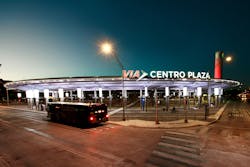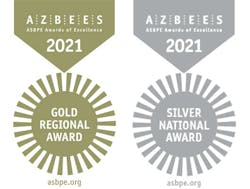In 2015, Rey Saldaña, former San Antonio City councilmember and past chair of the board for VIA Metropolitan Transit (VIA), traded in his car for a month to rely solely on transit and his bike to get him everywhere he needed to go. Throughout the month, he found that the buses were clean and the operators were friendly, but transferring and wait times were a sore spot, recalls Jeff Arndt, VIA president and CEO.
“He said, ‘I’m going to make it my mission to find you additional funding,’” Arndt said.
And in January 2018, Saldaña completed his mission when the city of San Antonio allocated $4.3 million to VIA. Beginning October 2018, the city elected to allocate $10 million annually. The additional funding made the partnership plan possible, which is an agreement between the city and VIA and focuses on increasing frequency throughout the system.
Minding the Gap
The additional funding from city council was a big financial gain for VIA. VIA operates on what Arndt calls a half-cent system. Unlike the Dallas and Houston transit agencies that receive a one-cent sales tax, VIA receives a half-cent share of local sales tax. VIA also receives a one-eighth cent share from the Advanced Transportation District (ATD), which is funded by a one-quarter-cent sales tax. The remaining one-quarter cent—the state of Texas allows up to on full cent of local sales tax to be used for transit funding—is allocated to the city to protect the Edwards Aquifer and Linear Creekways and fund the city’s Pre-K for SA program.
“Although we could ask for another half cent under the limits of the [state] legislature set for [metropolitan transit agencies], we cannot ask for that half cent under the limit that the state has set on local sales tax funding,” Arndt said. “That's our conundrum.”
To put this into perspective, sales tax makes up about three quarters of VIA’s budget. In FY20, sales tax accounted for 73 percent of VIA's revenue. Over the past 20 years, this half-cent difference, along with the greater economic level in Dallas and Houston, has created around a $5-6-billion gap when compared to the revenue the Dallas and Houston agencies have earned, Arndt explains.
“So, that put VIA--from day one--at a financial disadvantage compared to these other big systems,” Arndt said. “It’s not like we’re bringing in half of the money that Dallas is bringing in or Houston is bringing in. We’re bringing more like a third or fourth of the money that they’re bringing in.”
With the funding allowance for VIA at capacity, this left little to no room for the agency to implement transformational plans, such as VIA Reimagined, which is currently unfunded.
VIA’s Reimagined Plan builds on years of planning. In 2014, the city of San Antonio started to create SA Tomorrow, a comprehensive, long-range plan that includes three elements: the comprehensive plan, the sustainability plan and the multimodal transportation plan. In August 2016, VIA’s Board of Trustees adopted VIA’s Vision 2040 Plan, which was created in concert with the city’s multimodal transportation aspect of its long-range plan. Almost three years later, VIA Reimagined was introduced, a 10-year plan based on community-driven priorities identified in the VIA Vision 2040 Plan. VIA Reimagined serves as the first phase in executing that vision.
“Both Vision 2040 and VIA Reimagined incorporate and build on the SA Tomorrow Plan, primarily by increasing connectivity between the regional employment centers identified in SA Tomorrow,” said Lorraine Pulido, Ph.D., communications manager and public information officer, VIA.
Finding additional funding for the VIA Reimagined plan required some ingenuity. To do this, VIA Board Chair Hope Andrade met with San Antonio Mayor Ron Nirenberg and Bexar County Judge Nelson Wolff. They created an organization, ConnectSA, to compile the city’s multimodal transportation plan VIA’s 2040 Plan and VIA’s reimagined plan, along with other city plans, to identify gaps in funding. In December 2018, the organization released a draft of its findings, which identified the plan, what it cost, what funding was already there, what funding was needed and how that funding could be obtained, Arndt explains.
“Their plan at that point was everything, I would say, short of answering the funding part,” Arndt said.
Filling the Gap
Finding additional funding required strong partnerships with key stakeholders. In the beginning, it wasn’t VIA asking city officials for more funding to implement these transformational plans. It was Mayor Nirenberg and Judge Wolff who brought up the issue regarding lack of funding, both of whom have been advocates and supporters of improving public transit.
“Mayor [Nirenberg] and Judge [Wolff] have worked on finding a way to use other sources of funds that the city and county have to fund the aquifer protection and Linear Creekways piece of the [sales tax-funded] program, which is one-eighth cent sales tax,” Arndt said. “And then, that one-eighth cent sales tax would go to the voters for approval to add to VIA’s funding.”
If approved, that one-eighth cent sales tax would fund the expansion of services associated with the VIA Reimagined Plan, as well as capital costs such as more buses for the added service. However, this still leaves a vital part of the plan unfunded, which includes the creation of the Advanced Rapid Transit (ART) Program.
Although VIA is still searching for a way to fund the ART element of the plan, possibly through a future city bond program, it has been able to make several frequency improvements through the partnership plan thanks to the $10 million Saldaña advocated for.
“I’ll often say if real estate is location, location, location, transit is frequency, frequency, frequency,” Arndt said. “So, the partnership plan involved increasing frequency on 18 routes that were essentially in two sets.”
The partnership plan was implemented over three service changes beginning in January 2018 and ending January 2019. The first set of improvements involved increasing frequency on the hourly routes to running every 30 minutes. These routes saw a nine percent increase in ridership, something that Arndt says surprised him since he wasn’t expecting a significant response to 30-minute service. The other set of improvements included improving frequency on nine routes from every 15-20 minutes to every 10-12 minutes. These routes saw a 30 percent increase in ridership.
“These are routes that started with a healthy ridership and we just saw such a response and it was almost immediate,” Arndt said. “I was surprised at how quickly and how robustly that ridership changed.”
And beginning in September 2019, VIA started to see a five percent increase in ridership system wide.
“It wasn't just these nine high frequency routes and these nine 30-minute routes; we started to see it more pervasive in the system,” Arndt said. “Certainly that $10 million investment really helped contribute to that five percent [increase].”
More Funding; More Improvements
Proper funding will allow VIA to continue implementing service improvements, specifically the elements of the VIA Reimagined Plan, which range from the “Better Bus” and ART Program to “Smart Transit.”
The Better Bus concept has already commenced with the partnership plan and aims to move the system towards an average frequency of every 15-20 minutes during peak hours as opposed to the current 30-minute frequency. Along with expanding some express service, VIA also built two new facilities and created a park and ride in Stone Oak.
The ART element has been deemed the transformational piece of the plan and is designed to be a piece of the existing network. This allows ART to serve a broader community with more flexibility, making it more useful compared to VIA’s other services, such as the Express Service, which is designed to bring people from one suburban location directly to a key destination.
VIA has plans for two ART lines—north to south and east to west—to be completed by 2028, with future additional lines to be determined by the availability of funding. The ART lines would primarily along a dedicated right of way, with a series of intermediate stops. Arndt says ART would have distinct electric rubber tire vehicles and special station areas, along with off-board fare collection.
“ART seems to capture the imagination of the community and seeing that there would be a different way to deliver service in a way that could allow people who were on a bus to get around traffic, as opposed to be stuck in traffic even on a bus,” Arndt said.
The third and final piece to VIA Reimagined is Smart Transit, which involves harnessing technology that allows VIA to send out better information to customers and get back better information to inform the agency on how to better operate these technology-enabled services. One piece of the Smart Transit concept is VIA Link, a first/last mile service.
VIA Link is a pilot service that started in May 2019 on the northeast side of town, which at the time, had three bus routes that ran every hour. VIA Link operates in a 17-square-mile area as a demand-response, shared-ride service, allowing passengers to schedule a ride 30 minutes in advance and up to five days in advance through the VIA goMobile app or by phone. It charges the same as bus fares and provides free transfers that can connect riders to the bus system. The service is operated with RideCo, who provides the microtransit software, and Yellow Cab, RideCo’s subcontractor, provides the drivers.
Now, almost a year into operation, Arndt says wait times between requesting a trip and the vehicle arriving averages 10 minutes; about 50 percent of people share a ride; about 50 percent of people transfer to the bus system; and the cost per passenger is around 25 percent less than the fixed-route service. VIA Link has now replaced the initial three bus routes that were running in the same area.
“So, you have faster service, more direct service, less wait time [and] less expense,” Arndt said. “In our VIA Reimagined plan, we have expansion of this concept pretty much in a ring around the outer circumferential freeway here.”
It Starts at the Top
Arndt credits the board of trustees from the past decade for inspiring and encouraging the VIA Reimagined Plan, which pushed the agency to think bigger and better about its service offerings to the community and not just how cheaply something could be implemented due to budget constraints.
“What [the board] really instilled in VIA staff is we understand, especially because of the funding, that VIA typically made its decisions primarily based on how cheap we [could] do it,” Arndt said. “This board said we need to think bigger than that. We can never convince a community that VIA can be something more than what it is if we continue the same way we have been. They really empowered the staff to think bigger, to think grander.”
With the support from the board of trustees, in the past five years, VIA has made significant investments ranging from its bus fleet and facilities to its bus shelters and transit center program. The first investment went towards replacing nearly the entire fleet from mainly diesel buses to primarily compressed natural gas (CNG) vehicles, since the agency was holding on to several buses past their useful life. This meant VIA also had to construct a new CNG fueling facility, which fuels almost 600 vehicles.
VIA’s second investment went towards installing bus shelters. In two and a half years, the agency installed 1,000 bus shelters. Arndt says they estimate 95 percent of boardings in the system occur at a location with a shelter, which includes transit centers, park and rides or stops with a shelter.
“We have more shelters on the street than Los Angeles or Houston; we have about the same number of shelters on the street as Austin has bus stops,” Arndt explained.
VIA’s third investment went towards expanding its transit center program, one of which was VIA Villa, which includes Centro Plaza and The Grand. Centro Plaza is a transit hub that opened in November 2015 and features an air-conditioned waiting area, digital next-bus arrival signs and a full-service customer service center. The Grand is an old train depot that was purchased by VIA in 2010. Following the purchase and additional renovation, VIA staff moved into the building in 2014 and it now houses executive offices.
“The redevelopment of VIA Villa is envisioned as a return to the area’s historical use and its development as a modern multimodal transportation hub,” said the VIA Villa Vision Plan.
The Centro Plaza at VIA Villa now serves a little more than one million boardings a year and has four of VIA’s 10 busiest stations.
Thanks to advocacy from key stakeholders to receive additional funding, encouragement from leadership to branch away from business as usual and dedication from VIA staff to realize a bigger and better system, VIA is on the path to realizing the vision the board first saw.
“It really does start at the top with the board of trustees. They had a whole different picture of what VIA could be to the community,” Arndt concluded.
About the Author
Megan Perrero
Editor in Chief
Megan Perrero is a national award-winning B2B journalist and lover of all things transit. Currently, she is the Editor in Chief of Mass Transit magazine, where she develops and leads a multi-channel editorial strategy while reporting on the North American public transit industry.
Prior to her position with Mass Transit, Perrero was the senior communications and external relations specialist for the Shared-Use Mobility Center, where she was responsible for helping develop internal/external communications, plan the National Shared Mobility Summit and manage brand strategy and marketing campaigns.
Perrero serves as the board secretary for Latinos In Transit and is a member of the American Public Transportation Association Marketing and Communications Committee. She holds a bachelor’s degree in multimedia journalism with a concentration in magazine writing and a minor in public relations from Columbia College Chicago.


